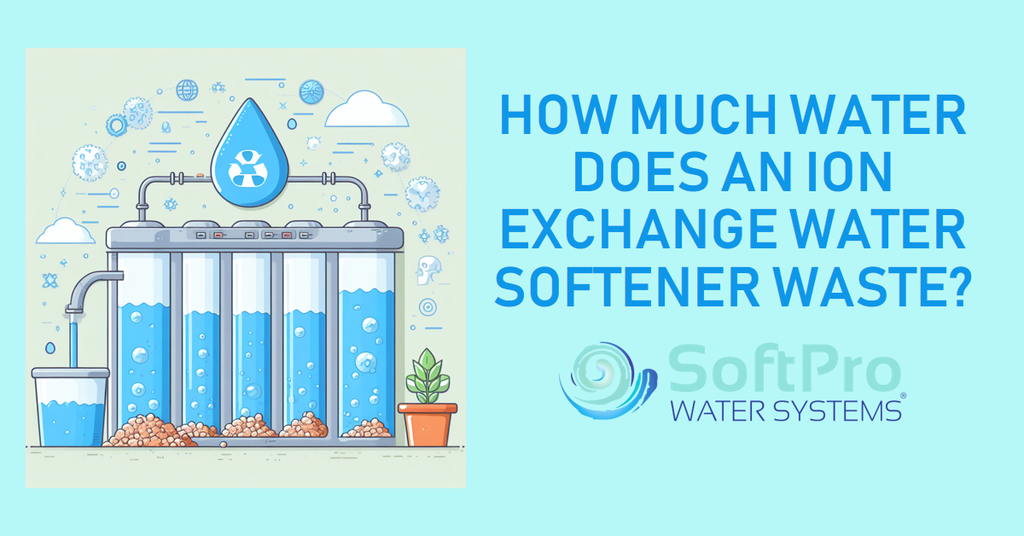On average, an ion exchange water softener wastes 25 gallons of water per day during the regeneration process. This translates to roughly 9,125 gallons per year. However, this is just an estimate, and the actual water waste can vary significantly depending on several factors:
- Water hardness: Harder water requires more frequent regeneration, leading to higher water waste. A study by the Water Quality & Health Council found that homes with hard water can experience up to 40% higher water waste from their softeners compared to those with soft water.
- Softener size: Larger softeners hold more water and consequently use more during regeneration. A 40,000-grain softener, for example, might use 35-40 gallons per regeneration, while a smaller 20,000-grain model might use around 20-25 gallons.
- Regeneration frequency: More frequent regeneration cycles naturally increase water waste. Some older models regenerate automatically at set intervals, even if not necessary, leading to unnecessary water usage.
- Technology: Newer, water-efficient models can significantly reduce waste compared to traditional ones. Demand-regenerating softeners, for instance, only regenerate when needed, leading to potential savings of 50% or more compared to older models.
Therefore, understanding the specific factors influencing your own softener's water waste is crucial for minimizing its environmental impact and potentially lowering your water bills. In the following sections, we'll delve deeper into these factors and explore strategies to mitigate water waste from your ion exchange softener.
Factors Influencing Water Waste
While the average water waste figure gives a starting point, it's crucial to understand the specific factors influencing your softener's individual water usage. This deeper dive will explore the key elements impacting waste and empower you to make informed decisions about minimizing it.
Impact of Water Hardness
Water hardness directly influences regeneration frequency and, consequently, water waste. Harder water contains higher levels of dissolved minerals like calcium and magnesium, which bind to the softener's resin beads. As these beads become saturated, the softener undergoes regeneration to clean them and restore their softening capacity.
Quantifying the Impact:
- A study by the Water Quality & Health Council found that homes with hard water (>200 ppm) can experience up to 40% higher water waste from their softeners compared to those with soft water (<75 ppm).
- An Environmental Protection Agency (EPA) report states that softening hard water (250 ppm) with a traditional softener can use up to 60 gallons per regeneration, whereas softening soft water (75 ppm) might only require 20-25 gallons.
Softener Size Matters
While water hardness plays a significant role, the softener's size itself also affects water waste. Larger softeners, measured in grain capacity, hold more water and use more during regeneration.
Understanding Grain Capacity:
- Grain capacity indicates the softener's ability to remove hardness minerals before needing regeneration. Higher grain capacities, like 40,000 grains, typically use 35-40 gallons per regeneration, while smaller models like 20,000 grains might use 20-25 gallons.
- Choosing a softener size appropriate for your household water usage and hardness can help optimize water consumption.
Quantifying Your Waste: Tools and Resources
Now that we understand the key factors influencing water waste, let's explore practical ways to assess and quantify your specific situation. These tools and resources can empower you to make informed decisions about minimizing your softener's environmental impact and potentially reducing water bills.
Water Waste Calculator
Several online water waste calculators can estimate your softener's daily and annual water usage based on specific parameters. These tools typically require information like:
- Your water hardness: Measured in parts per million (ppm) or grains per gallon (gpg), you can obtain this information from water test results or contact your local water utility.
- Softener size: Measured in grain capacity, typically found on the softener's label or manual.
- Regeneration frequency: If you know the current frequency, input it, or if not, the calculator might offer estimates based on water hardness and softener size.
Benefits of Using Calculators
- Gaining Insights: Calculators provide an immediate estimate of your softener's current water waste, raising awareness about potential environmental and cost implications.
- Comparing Options: When considering a new softener, you can input different models' specifications and compare their estimated water waste, guiding your decision towards more efficient choices.
Minimizing the Waste: Practical Tips and Solutions
Now that we've identified the factors influencing water waste and equipped ourselves with tools for quantifying it, let's delve into practical strategies for minimizing waste from your ion exchange water softener. Remember, every drop saved contributes to a more sustainable water future.
Optimizing Regeneration Settings
Many softeners allow you to adjust the regeneration settings, offering opportunities to reduce water usage. Here are some key steps:
- Reduce frequency: If your softener regenerates automatically at set intervals, consider extending the time between cycles based on your water usage and hardness. Consult your softener's manual or manufacturer for guidance.
- Shorten the cycle: Some models allow adjusting the regeneration cycle length. While shorter cycles might not be as thorough, they can still be effective for soft or moderately hard water, reducing water usage.
- Demand-regeneration options: Consider upgrading to a demand-regenerating softener. These models only regenerate when necessary, based on actual water usage, leading to significant water savings compared to traditional timers.
Maintenance Matters
Proper maintenance can enhance your softener's efficiency and minimize water waste. Here are some key practices:
- Clean salt reservoir regularly: A clean salt reservoir ensures optimal brine concentration, leading to more efficient regeneration and less wasted water. Refer to your manual for recommended cleaning intervals.
- Check for leaks: Leaky valves or connections can waste significant water. Regularly inspect your softener for any leaks and address them promptly.
- Consider professional maintenance: Periodic professional maintenance (typically every 2-3 years) can ensure your softener operates optimally and identify potential issues that might lead to unnecessary water waste.
Exploring Water-Saving Features
Technology provides innovative solutions for minimizing water waste in softeners. Consider these features when choosing a new model or exploring upgrades:
- Dual tank systems: These systems offer continuous soft water supply while one tank regenerates, eliminating the need for complete system downtime and potentially reducing wasted water during the process.
- Sensor-based controls: Some models include advanced sensors that monitor water flow and hardness, triggering regeneration only when necessary, further optimizing water usage.
- Leak detection and prevention systems: These features can quickly identify and stop leaks, preventing significant water waste.
Alternative Softening Options and Lifestyle Adjustments
While minimizing water waste with your existing ion exchange softener is crucial, exploring alternative options and implementing lifestyle adjustments can further reduce your environmental impact and potentially decrease water bills. Consider these additional strategies:
Exploring Alternative Softening Technologies
- Salt-free softeners: These systems use alternative technologies like template resins or chelation to soften water without requiring regeneration cycles, thereby eliminating water waste. However, their effectiveness and maintenance requirements can differ from traditional softeners.
- Magnetic water conditioners: These devices claim to alter water's properties without using chemicals or altering its mineral content. However, their effectiveness in softening water remains scientifically unproven, and their environmental impact is unclear.
Implementing Lifestyle Adjustments
- Targeted softening: Instead of softening all your household water, consider point-of-use softeners for specific appliances like dishwashers and washing machines. This reduces overall water usage for softening.
- Water-efficient appliances: Investing in water-efficient appliances like dishwashers and washing machines can significantly reduce water consumption, complementing the efforts to minimize softener waste.
- Mindful water usage: Simple daily habits like running shorter showers, fixing leaky faucets, and using water-saving methods while washing dishes or clothes can further contribute to overall water conservation.
Choosing the optimal approach depends on your specific water hardness, household water usage, budget, and environmental considerations. Researching and comparing different options can help you make informed decisions to achieve both effective softening and water conservation.
Conclusion and Key Takeaways: Softening Your Water Wisely
While ion exchange water softeners offer undeniable benefits in combating hard water woes, their water waste footprint warrants mindful consideration. Understanding the factors influencing waste, from water hardness and softener size to regeneration frequency and technology, is crucial for minimizing environmental impact and potentially lowering water bills.
This article has equipped you with valuable tools and strategies to achieve just that. Remember, quantifying your waste through online calculators like the Water Quality & Health Council's or the WaterSense Water Softener Calculator is the first step towards informed action.
Once you have a clear picture, optimizing regeneration settings takes center stage. Extending the intervals, shortening the cycle length, and even considering demand-regenerating models can significantly reduce water usage. Regular maintenance, from cleaning the salt reservoir to checking for leaks, also ensures your softener's efficiency and minimizes waste.
For those seeking alternatives, exploring salt-free softeners or implementing lifestyle adjustments like targeted softening, water-efficient appliances, and mindful water usage habits, can further contribute to water conservation. Ultimately, the optimal approach depends on your unique needs and priorities.
Key Takeaways
- The average ion exchange water softener wastes 25 gallons of water per day, but this figure can vary significantly based on several factors.
- Water hardness plays a major role, with harder water requiring more frequent regeneration and leading to higher waste.
- Softener size also matters, with larger models using more water during regeneration.
- Optimizing regeneration settings, regular maintenance, and exploring water-saving features can significantly reduce water waste from your softener.
- Alternative softening technologies and lifestyle adjustments offer further options for minimizing your environmental impact.
By implementing these strategies and adopting a mindful approach to water usage, you can ensure your water softener delivers its benefits without unnecessary environmental and financial costs. Remember, every drop saved contributes to a more sustainable water future for us all.


















![Aldex Premium 10% Cross Link Resin for Water Softener [High Capacity]-SoftPro® Water Systems](http://www.softprowatersystems.com/cdn/shop/files/Aldex_10_Cross_Link_Resin_Premium_High_Capacity_for_Water_Softener_600x.jpg?v=1735853599)





















